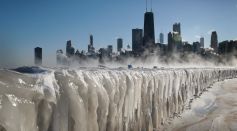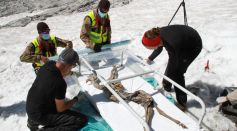Tags: Ice
New Study Might Explain Crystalline Ice’s Anomalous Behavior
What Would Happen to Earth If All The Ice Will Melt?

Tetrahedral Form of Water Might Explain Its Unique Behavior

3 Characteristics of Water That Seem to Defy the Laws of Physics

400-Year-Old Frozen Goat Offers Insight on Ice Mummies

Ice Sheets Created Mars Valleys, Not Rivers
The Sea Around North Pole Will Become Ice-free in the Summer Before 2050 Even If Temperatures Are Kept Under 3.6°F
New Defrosting System Could Potentially Reduce Flight Delays
Troubling Signs Found Beneath Greenland Ice
Snow Algae Flourish in High-Elevation Ice Spires, an Unlikely Oasis for Life
How the Ice on Mars Melts
Recently Known Ways Insects and Bacteria Control Ice
The Imminent Collapse of the “Doomsday Glacier”
Arctic Negribreen Glacier In Norway Spotted By ESA’s Satellite To Be On The Move
Earth Has Been Through Not One But Many Ice Ages
Record Breaking Temperature In Antarctica After 1980, WMO Confirms 63.5 Degrees F In 2015 Denotes the Balmiest Year Ever
World Meteorological Organization Announced The High Temperature Recorded In Antarctica Region
Antarctic New Iceberg: Further Evidence Of Pine Island Glacier’s Fragility?
Mathematical Formula Explains Why Ice Is Slippery
Antarctica's Ice Shelves Melting Faster Than Originally Thought
Most Popular

3I/Atlas Alien Comet 'Seen' on Earth? TikTok Users Claim Interstellar Object Captured on Camera

3I/ATLAS: The Truth Behind the Mysterious Interstellar Object Now Targeted by NASA and UN Teams

Hellfire Missile Video Reveals MQ-9 Reapers Being Used for Aerial Combat

Nvidia's Jetson Thor Could Make Humanoids Smarter Than Ever




